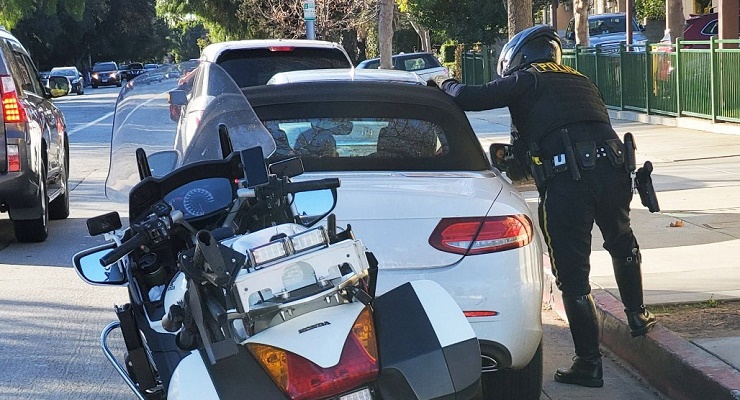In the wake of a recent epidemic of collisions involving cars and pedestrians and cyclists, the Pasadena City Council this week was briefed on two programs one a series of pedestrian and bicycle initiatives to help curb the rising tide of such incidents and the other an ambitious plan to actually eliminate traffic deaths in the city of Pasadena by 2027.

According to Monday’s Department of Transportation presentation before City Council, only 18 percent of travelers in Los Angeles County are pedestrians and only one percent are cyclists, yet in Pasadena, cyclists account for 15 percent of traffic deaths and injuries and pedestrians account for 30 percent.
The number of total fatalities and injuries has dipped slightly from 31 in 2006 to 26 in 2015. Pedestrian fatalities ranged from ten in 2006 to six in 2015, and bicyclist fatalities and serious injuries dropped from six in 2006 to three in 2015.
However, in recent weeks Pasadena has seen an uptick in collisions with the death of a local motorcyclist and two serious car-versus-pedestrian collisions, including one on Monday shortly before the Council meeting.
According to the presentation, the accidents have varied in locations to all points in the city, with a large number occurring north of the 210 freeway in and around Orange Grove Boulevard.
The City initiatives, which acknowledge that accidents are random, still aim to prevent accidents through a number of elements, including education, encouragement, enforcement and engineering. The new initiatives would also include collaborations with the police department, the department of transportation, the public health department, and the public works department.
At the same time, a new policy called Vision Zero, which aims to eliminate all traffic deaths in Pasadena by the year 2027, was introduced to the council by Misch Anderson, on behalf of the Pasadena Complete Streets Coalition, an association of ten community-based organizations.
Anderson has asked the city to formally adopt the program as city policy. “Similar programs have already been adopted by the cities of Los Angeles, San Francisco, Seattle, New York, Portland, Chicago, and San Jose,” said Anderson, in a letter to Mayor Terry Tornek.
According to Anderson, Vision Zero “promotes the safety of all road users, prioritizing the most vulnerable: children, the elderly and people who walk and bike.”
Like the city’s pedestrian and bicycle safety initiatives, the Vision Zero program also works on four main principles—Engineering, by evaluating how streets and sidewalks are designed, to anticipate human error and minimize the consequences of mistakes on the road; Education by raising awareness of street safety by all users; Enforcement, the enforcement of laws against dangerous driving behavior in areas with high collision rates; and Evaluation, the use of data to target areas most in need, to evaluate successes and failures, and to improve on those results.
Vision Zero would also examine the issue of equity, ensuring that benefits are prioritized for areas that might have been previously neglected, Anderson told the Council.
The city of Pasadena has engaged in a number of safety initiatives and campaigns since at least 2005, from a 2006 pedestrian safety plan, to updated maps for safer routes to school, as well as traffic safety assessments, and outreach in carious parts of the city, through community and neighborhood groups.
The City also initiated a “Ride Right, Ride Bright” bicycle safety campaign in 2015, and distributed free helmets and bike lights at various community events. There were also “Walk to School” safety events as well as a number of safety outreach programs for students.
In addition, the department of engineering has created several pedestrian safety initiatives, including the El Molino Ave raised crosswalk with in-roadway warning lights in the Playhouse District, as well as the Allendale Road crosswalk.
As part of the Great Streets Initiative, the city has also been actively creating a host of bicycle safety programs, including new bike lanes and crosswalk, as well a new dedicated state-of-the-art cycle track to be built on Union Avenue from Arroyo to Holliston Street.
The department has also installed new left turn signals at Colorado Blvd and Orange Grove Blvd; Orange Grove Blvd at Holly Street, and Colorado Blvd and Fair Oaks Ave, along with Bicycle Detection at Signalized Intersections, and Safety Enhancements at Lincoln Ave and Forest Ave and Lincoln Ave and Mountain Street, along with new enhancements along Avenue 64 and a new “complete street” on Lida Street between Knollwood Drive and Lancashire Place.
Meanwhile, the Vision Zero group is planning study sessions to present Pasadena-specific data regarding high-injury streets and intersections, and seek community input at upcoming meetings, with the final goal of the adoption of the Vision Zero policy.
As Anderson wrote, “Leadership is the first component of a successful Vision Zero program. When the City adopts Vision Zero as the stated goal, it provides all staff, law enforcement and community members with a tangible, actionable goal. Departments then use that goal in planning priories and measuring success.”














 0 comments
0 comments


